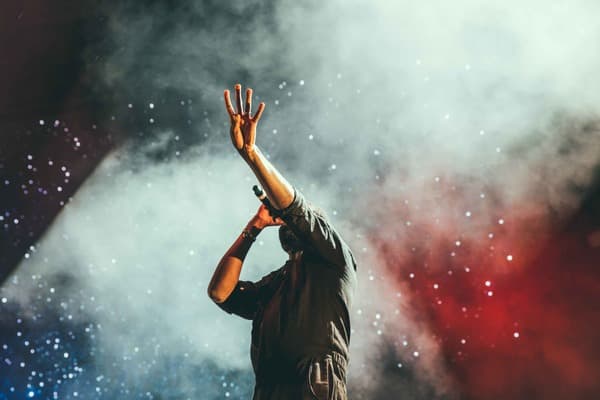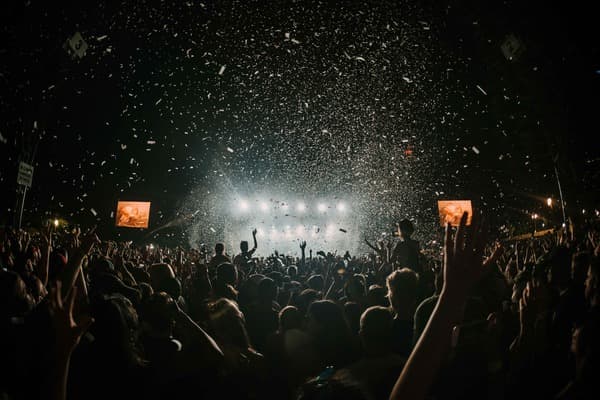July 10, 2023
Tinnitus in Musicians
Article Navigation: Quick Access to Sections
Tinnitus, characterized by persistent ringing or buzzing in the ears, has long been a silent epidemic among musicians and DJs. Constant exposure to loud music, both in performances and practice sessions, significantly increases the risk of developing tinnitus in musicians. This article explores the prevalence of tinnitus in the music industry, effective hearing protection for musicians, and coping mechanisms for those already experiencing symptoms.

Introduction: The Silent Epidemic in the Music Industry
Music represents passion, creativity, and livelihood for millions worldwide. Yet, hidden behind the energy of performances and the dedication of practice is a pervasive and often overlooked issue—tinnitus. For musicians, DJs, and sound engineers, the very element that defines their craft can also pose a significant threat to their auditory health.
Tinnitus manifests as persistent ringing, buzzing, hissing, or other phantom sounds in the ears, which can severely impact a musician's professional capabilities and personal life. Understanding the unique risks faced by those in the music industry is the first step toward prevention and effective management.
Why Are Musicians Particularly at Risk for Tinnitus?
Musicians and music industry professionals consistently face a trifecta of major tinnitus risk factors:
- Excessive sound exposure: Concerts, rehearsals, club environments, and studio sessions regularly expose musicians to hazardous decibel levels, often well above safe listening thresholds.
- Long-duration exposure: Prolonged practice hours and repeated performances increase the cumulative dose of sound exposure, heightening the risk of auditory damage over time.
- Reluctance towards or improper use of hearing protection: Historically, many musicians have avoided or incorrectly used ear protection, fearing it might compromise sound quality, their connection with the music, or their performance.
This combination of factors significantly raises the prevalence of tinnitus among musicians and DJs, highlighting an urgent need for greater awareness, education, and proactive hearing conservation measures within the industry.
The Prevalence and Impact of Tinnitus Among Musicians
How Common Is Tinnitus in the Music Profession?
Research consistently indicates that musicians are at a substantially higher risk of developing tinnitus compared to the general population, with some studies suggesting they are nearly four times more likely. It's estimated that over half of professional musicians report experiencing tinnitus symptoms at some point in their careers. (For general prevalence, see tinnitus statistics).
- DJs and electronic music artists: Often face particularly high risks due to performing in extremely loud nightclub environments with powerful sound systems for extended periods.
- Rock, metal, and pop musicians: Regularly experience intense volume levels during live shows and rehearsals, increasing their vulnerability to noise-induced hearing loss and tinnitus.
- Classical musicians: Even orchestral instruments can produce sound levels that are surprisingly harmful over time, with some sections or specific instruments reaching peak volumes of up to 100-120 decibels, comparable to loud machinery.
Tinnitus and Its Impact on a Music Career
The onset of tinnitus can severely disrupt a musician’s career and well-being:
- It can affect their ability to accurately perceive pitch, timbre, and dynamics, all of which are crucial for performances, composition, and studio work.
- It can cause significant psychological stress, often leading to anxiety and depression, affecting concentration and creativity.
- In severe cases, it can prompt early retirement from a beloved profession due to the unbearable nature of the symptoms or associated hearing loss.
Notably, many prominent musicians, like Pete Townshend of The Who, have publicly shared how tinnitus has deeply impacted their professional lives, underscoring the critical importance of proactive hearing protection from the outset of a music career.
Prevention: Protecting Your Hearing Without Sacrificing Sound Quality
The good news is that much of the risk of musicians' hearing loss and tinnitus can be mitigated through effective prevention strategies that don't compromise the musical experience.
Customized Musician Earplugs
Unlike standard foam earplugs that muffle and distort sound, specialized musician earplugs (often called "high-fidelity" or "flat-response" earplugs) are designed to provide balanced sound reduction across different frequencies. Custom-molded earplugs, fitted by an audiologist, offer:
- Natural sound preservation, allowing music to be heard clearly but at a safer volume.
- Comfort for prolonged use during long rehearsals or performances.
- Often, adjustable noise reduction filters for different sound environments.
Safe Listening Habits
- Adopt practices like the "60/60 rule" when using headphones for personal listening or monitoring: listen at no more than 60% of the maximum volume for no longer than 60 minutes at a time before taking a break.
- Regularly schedule "acoustic breaks" during long rehearsals and live shows to give your ears time to recover.
- Maintain a safe distance from loudspeakers, amplifiers, and other loud sound sources whenever possible.
Advanced Monitoring Solutions
- Use in-ear monitors (IEMs). These devices can provide a clear, controlled mix directly to the musician's ears at safe volume levels, reducing the need for loud on-stage wedge monitors and protecting from excessive stage volume.
- Employ decibel-monitoring apps or wearable devices to track personal sound exposure levels in real-time, providing valuable feedback for adjusting listening habits.
Regular annual hearing tests conducted by an audiologist are crucial for musicians to detect any early signs of hearing loss or tinnitus, allowing for prompt intervention and prevention of further damage.
Effective Coping Strategies for Musicians with Tinnitus
For musicians already experiencing tinnitus, various strategies can help manage the symptoms and maintain their quality of life and ability to perform.
Sound Therapy and Masking
Sound therapy can significantly mitigate the perception of tinnitus by redirecting the brain’s auditory attention:
- White noise machines or apps can create a soothing ambient soundscape, particularly helpful in quiet environments or for sleep. Explore options in our Zen sound library.
- Pink noise and various natural sounds can offer calming auditory stimulation.
- Hearing aids equipped with masking technology can offer continuous relief for those with accompanying hearing loss.
Cognitive Behavioral Therapy (CBT)
CBT is a highly effective psychological approach for managing the distress often associated with tinnitus by:
- Helping musicians reframe negative or catastrophic thoughts and perceptions about their tinnitus.
- Teaching practical coping strategies to manage stress, anxiety, and focus issues related to tinnitus.
- Often incorporating mindfulness and relaxation techniques into daily routines to reduce overall arousal.
Lifestyle Changes
Small but consistent lifestyle adjustments can greatly influence tinnitus severity and perception:
- Consider limiting intake of potential triggers like excessive caffeine and alcohol, which can exacerbate tinnitus for some individuals.
- Practice active stress management through techniques like meditation, yoga, or mindfulness.
- Engage in regular physical exercise to boost circulation and promote overall auditory and neurological health.
Professional Support and Guidance
Consulting an audiologist or ENT specialist experienced in tinnitus treatment for musicians is vital. They can provide a personalized care plan, recommend appropriate hearing protection, discuss advanced therapies, and offer ongoing support for symptom management.

Famous Musicians with Tinnitus: Lessons and Awareness
Many renowned musicians have courageously shared their experiences with tinnitus, providing valuable lessons for upcoming artists and powerfully advocating for hearing protection:
| Musician | Experience with Tinnitus and Advocacy |
|---|---|
| Chris Martin (Coldplay) | Emphasizes the necessity of using custom ear protection after developing tinnitus early in his career. |
| Eric Clapton | Has spoken about tinnitus and hearing loss as significant personal and professional challenges resulting from years of loud performances. |
| Lars Ulrich (Metallica) | Developed tinnitus from decades of powerful drumming; now strongly promotes ear protection awareness among fans and fellow musicians. |
| Ozzy Osbourne (Black Sabbath) | Has openly warned younger musicians about the critical importance of hearing protection due to his own struggles with hearing loss and tinnitus. |
| Pete Townshend (The Who) | Famously battles severe tinnitus and hearing loss, attributed to extremely loud concerts, and consistently advocates for hearing safety. |
| Neil Young | Encourages proactive hearing care, having openly discussed his experience with tinnitus and hyperacusis. |
| Sting | Has reported suffering from tinnitus symptoms due to prolonged music exposure and actively advocates for responsible listening and hearing protection. |
| Phil Collins | Experiences tinnitus and hearing loss after a long career of performing and recording, often speaking out to raise awareness about hearing health. |
| Will.i.am (Black Eyed Peas) | Openly talks about his tinnitus, using his platform to warn fans and musicians about the risks associated with exposure to loud music. |
Their stories collectively highlight the critical need for increased awareness, better hearing protection practices, and proactive hearing care within the entire music community.
For more inspiring examples and stories, read our detailed article on Celebrities with Tinnitus.
Advancements and the Future of Hearing Protection for Musicians
The approach to hearing health in the music industry is evolving, with positive trends in technology and awareness.
Emerging Technologies
Innovations are continually enhancing the effectiveness and usability of hearing protection and tinnitus management tools:
- Smart earplugs and IEMs with features that can automatically adjust sound levels or offer personalized profiles.
- AI-driven tinnitus relief apps that offer highly customized sound therapy solutions and management programs.
- Bone conduction technologies are being explored as alternative auditory support systems for some individuals.
Raising Industry Awareness
- Many music organizations, foundations, and educational institutions are increasingly promoting hearing health initiatives and providing resources for musicians.
- Educational programs for musicians and audio engineers now more frequently include topics on hearing conservation and safe sound practices.
Regulatory and Venue-Based Measures
- Some regions and venues are implementing or considering guidelines or regulations for safe decibel levels at live events, encouraging responsible event management and prioritizing hearing safety for both performers and audiences.
Conclusion: Ensuring a Healthy and Enduring Musical Future
Tinnitus poses a significant, yet largely preventable, threat within the music industry. Musicians, DJs, and all music professionals can effectively safeguard their precious hearing through education on the risks, consistent use of specialized protective measures like musician earplugs and IEMs, commitment to regular hearing assessments, and the adoption of responsible listening habits.
By proactively protecting their auditory health, musicians can continue pursuing their passion and career without the debilitating compromise of tinnitus or significant hearing loss. Prioritizing hearing protection for musicians today ensures that music remains a lifelong joy and a sustainable profession, rather than a source of lasting health consequences.